History
Ratu Boko is Located about 3 km south of Prambanan. Ratu Boko is situated atop of a hill ± 195.97 m above sea level. Ratu Boko is not a temple, but a remains of a palace. Ratu Baka is often called Kraton Ratu Boko. Legend said that Ratu Boko once a palace for Ratu Boko, the father of Lara Jonggrang. Ratu Boko is built during the 8th century AD by the Buddhist Syailendra Dynasty, but then the Hindu Mataram kings took over the place. This take over makes Kraton Ratu Boko is full of Hindu and Buddhist references.
A stele was found in Ratu Boko dated 792 AD named Prasasti Abhayagiriwihara. This Stele signs that the Ratu Boko was built by Rakai Panangkaran. Prasasti Abhayagiriwihara is written with Pranagari font, a font used by many Buddhist Steles. In the Stele was mentioned Raja Tejapurnama Panangkarana, which is another name for Rakai Panangkaran. Tejapurnama Panagkarana ordered the construction of Abhayagiriwihara. The same name also mentioned in Kalasan Stele (779AD), Mantyasih Stele (907AD), and Wanua Tengah III Stele (908AD). Abhaya means peaceful, giri means hill or mountain. Abhayagiriwihara means a monastery built on a hill of peace. During the reign of Rakai Walaing Pu Kombayoni (898-908AD), Abhayagiriwihara changed its name to Kraton Walaing.
Gate
The entrance to Ratu Boko compound is on the west side, it sits quite high from the car park. In order to reach the gate, visitors must walk 100 meters from the ticket entrance. The Ratu Boko gate has two parts, the inner gate is bigger than the outer gate. The inner or main gate is located 15 meters from the outer gate. The inner gate has five Gapura (gopuram) Paduraksa aligned with the outer gates. The main gapura is flanked by two smaller gapuras by the side. Even though there are five gapuras, the re are only three stairs connecting the gapuras from the outer gate. The gate is adorned with flowers and tendrils ornament.
Batukapur Temple
45 m from the main gate to the northeast, a foundation from limestone was found. The Batukapur Temple means temple made of limestone.
Pembakaran Temple
Paseban
Paseban is a Javanese word for Royal Court to meet the king. The Paseban is located 45 meters south of the main gate. The Paseban was built facing north and south. The stairs to the Paseban is located in the west. Foundations was found around the Paseban, which means that the Paseban is originally a closed structure.
Pendapa
20 meters south from the Paseban is a stone wall three meters high forming a gate of a compound. In the north, west, and south side of this wall is an entrance in form of Gapura Paduraksa (roofed gopuram). Several Jalawadra also found around the Pendapa. Jalawadra is a waterway, also present in Banyuniba and Borobudur Temple. In Javanese, Pendapa means a pavilion for guests usually located in the front of a house.
Outside the Pendapa walls, 3 little temples are used for worship. The middle temple is the biggest, used to worship Vishnu, the other two used for Brahma and Shiva.
Keputren
Keputren is a place for the royal princess. Located eastward of the Pendapa. Keputren is divided by two stone walls. The first section has three square pools, while the second section has eight circle pools lined in three rows.
Caves
Caves are located in the hill slopes. The two caves was named Gua Lanang (male) and Gua Wadon (female). Gua Lanang is a square shaped cave, and having a frame-like carving on the wall. Gua Wadon is smaller than the Gua Lanang.
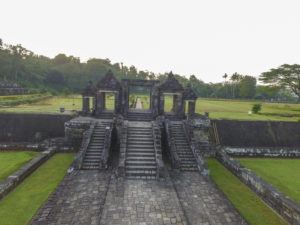
Ratu Boko Entrance

Ratu Boko Ruins
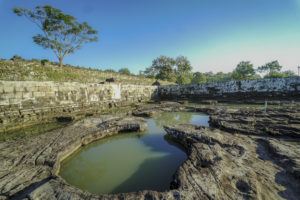
Ratu Boko Pools
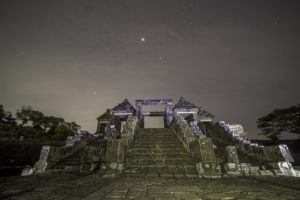
Ratu Boko at Night
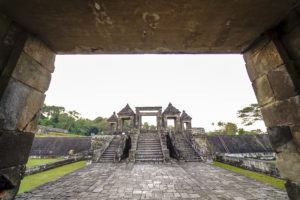
Ratu Boko Gate
Gallery
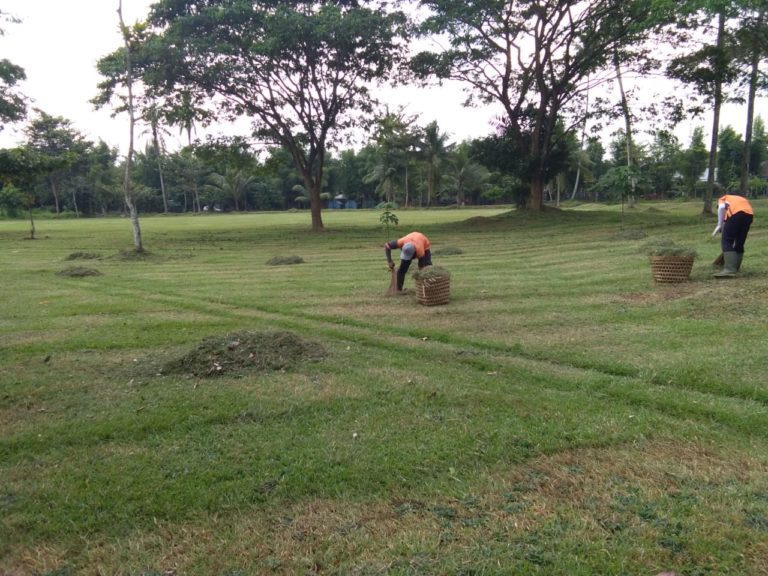
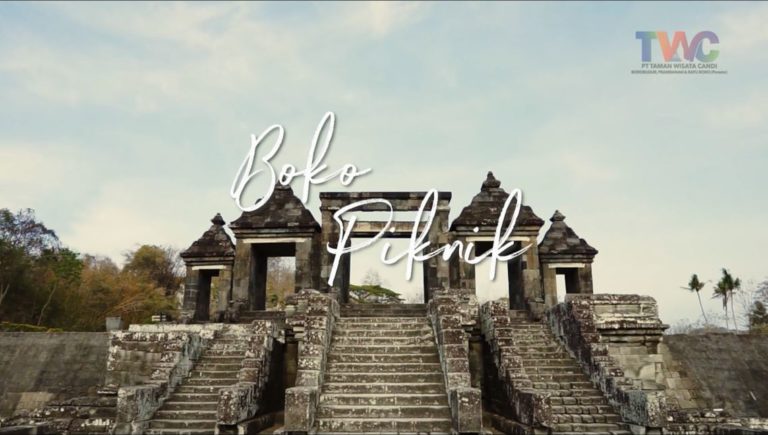
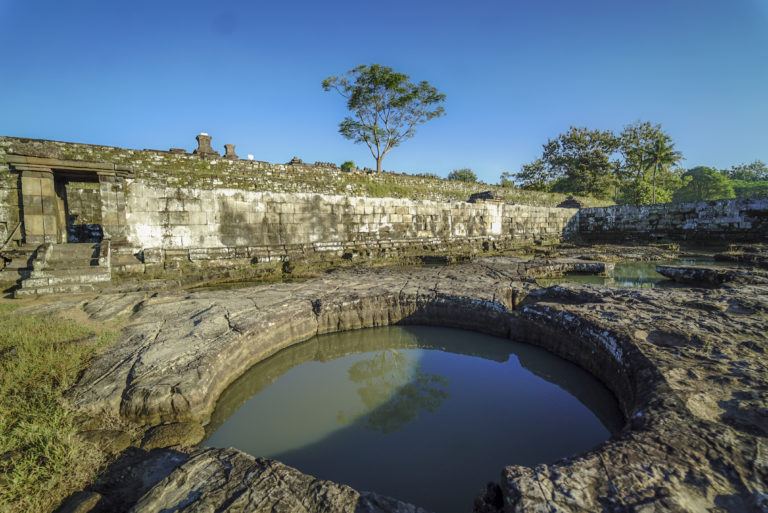


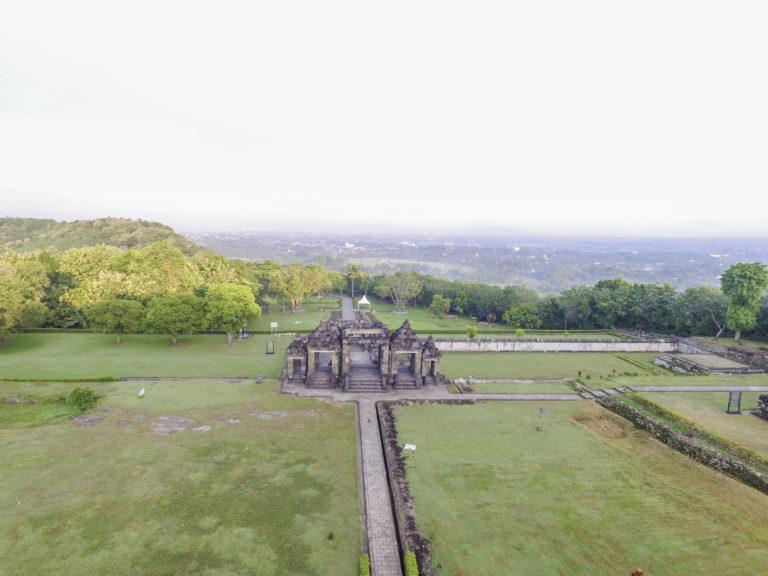
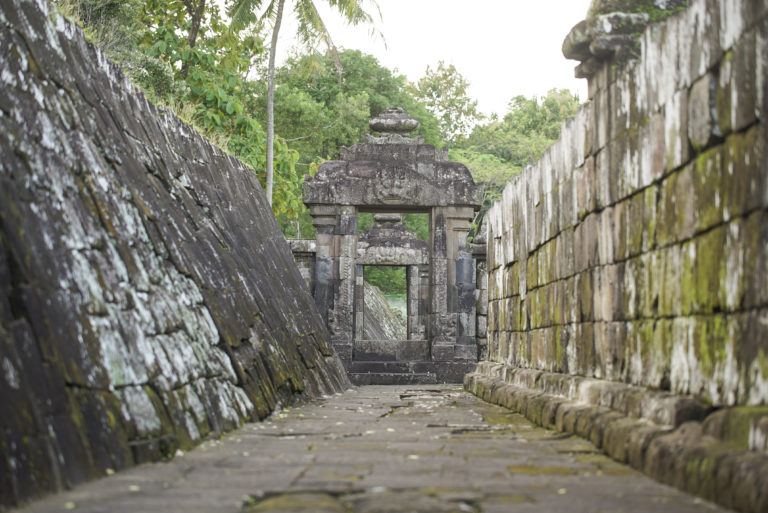

How to Get There
Nearest large city from Ratu Boko is Yogyakarta. Yogyakarta International Airport is currently serving international flights from Singapore and Kuala Lumpur. Other cities closely located to Ratu Boko is Klaten, but has no international hub.
Ratu Boko is located near Prambanan, which itself located in a major road connecting Yogyakarta and Solo through Klaten. Available public transportation from Yogyakarta only serve until Prambanan area, so you must rely on local transportation mode like motorcycle taxi from Prambanan to Ratu Boko.
From Train Station
From Tugu Yogyakarta Train Station you can ride a taxi or rent a car. The Ratu Boko Palace is 30 minutes drive or 20 km from the station. Public Transportation available in Transjogja bus lane 1A. You ride the bus on Mangkubumi bus stop and continue until pasar Prambanan bus stop. From there you can continue using motorcycle taxi to Ratu Boko Palace.
From Adisutjipto Airport
From the Adisutjipto airport you can take a taxi or rent a car. The distance between Ratu Boko and the airport is 8.4 km or 15 minutes on car. Public Transportation available in Transjogja lane 1A to the pasar Prambanan bus stop. From there you can continue using motorcycle taxi to Ratu Boko Palace.
Private Vehicle
Ratu Boko is accessible eastward from Jalan Raya Jogja Solo or the airport. You need to go east until the Pasar Prambanan three way intersection. From there take the right road and continue to Prambanan - Piyungan road. In about 3 km you will see the sign to Ratu Boko Palace. The palace is located on the left side of the road on top of a hill.
Where to Sleep
Ticket Information
One time entrance ticket per person
TW Ratu Boko
- >10 years old: USD 25
- aged 3 to 10: USD 15
Ticket includes Rp 1.000 insurance premium
Ticket Packages
Ratu Boko – Prambanan (with free shuttle services between two temples)
- >10 years old: USD 45
- aged 3 to 10: USD 27
Ratu Boko – Borobudur
- >10 years old: USD 45
- aged 3 to 10: USD 27